#Innovative Construction Methods
Explore tagged Tumblr posts
Text
#3D Printing#Construction#ShreeTMT#Construction Technology#3D Printing Benefits#Types of 3D Printing#Uses of 3D Printing#Innovative Construction Methods#Efficient Building Processes#Cost Reduction in Construction
0 notes
Text
World’s first 3D-printed mosque opens in Saudi Arabia
It is located on an area of 5,600 square meters and took approximately six months to construct. A Pioneering Project Takes Shape Marking a significant leap in construction technology, Jeddah, Saudi Arabia, recently celebrated the opening of the world’s first 3D-printed mosque. Named after the late philanthropist Abdulaziz Abdullah Sharbatly, this architectural marvel stands proudly in the…

View On WordPress
#3D printed mosque#3D printing technology in construction#Abdulaziz Abdullah Sharbatly mosque#digitalislamic#digitalislamicguide#Future of construction#Innovative construction methods#Islam#Jeddah 3D printed mosque#saudi arabia#Saudi Arabia 3D printing#Saudi Vision 2030 and construction#Sustainable mosque construction#World&039;s first 3D printed mosque
0 notes
Text
Professional Technical and Landscape Service
Introduction:
Technical and Landscape service www.softstardubai.ae is best company in Dubai.
Dubai known for its awe-inspiring skyline and innovative infrastructure, is a thriving metropolis that constantly evolves and embraces technological advancements. To support the city’s development and maintain its captivating landscapes. Moreover and wide again and range of the Soft Star technical and more landscape services have emerged near too Dubai. These are services play again pivotal role in enhancing urban living and then again by providing state of the art solutions for construction maintenance and green space etc.
Technical Services:
Dubai’s rapid growth necessitates the expertise of technical service providers who specialize in various areas. First Construction companies second architectural firms and engineering consultancies offer their expertise in designing and building iconic structures that define the city’s landscape. In addition from too be towering skyscrapers too intricate urban planning and again these technical
services contribute to Dubai’s unique skyline and urban fabric.
Moreover, facilities and management companies are key players in maintaining the functionality and efficiency of Dubai’s infrastructure important. They provide comprehensive services. Moreover maintenance repairs, and energy again management for residential and commercial buildings, ensuring that the city’s facilities operate seamlessly.
Landscape Services:
Dubai’s commitment to creating lush green spaces amidst its urban environment has led to a thriving landscape services industry. Landscape architects and designers are instrumental in transforming open areas. and parks and gardens into breathtaking landscapes. By integrating sustainable design practices and innovative techniques or they harmonize the natural and built environments. They providing residents and visitors with serene and aesthetically pleasing surroundings.
To ensure the well-being of these green spaces and landscape maintenance companies employ skilled horticulturists and gardeners. They meticulously care for the plants or trees and lawns ensuring their health and vitality. From irrigation systems to pest control, these services maintain the beauty and functionality of Dubai’s green areas.
Best Technical and Landscape service:
Technical and Landscape service to a range of professional service focused on the design or installation and maintenances of the outdoor spaces and the infrastructure associated with them. These services are essential for creating aesthetically pleasing and functional environments in residential or commercial and public settings.
Synergy between Technical and Landscape Service:
The seamless integration of technical and landscape services near Dubai offers numerous benefits to the city and its residents. Furthermore By combining innovative construction again
methods with sustainable landscape designs. In addition they create too harmonious urban environment that prioritizes both aesthetics and functionality more.
For instance, incorporating green spaces within too skyscrapers not only enhances the visual appeal but also improves air quality and provides a retreat for residents. Next Technical services contribute to the construction of these green buildings. landscape services maintain and nurture the plants within them.
Conclusion:
The availability of technical and landscape services near Dubai. They played a vital role in shaping the city’s infrastructure and green spaces. Finally through their expertise again more commitment too innovation. These service providers contribute to Dubai’s reputation and as a global hub of modernity and sustainable living etc. Moreover as the city and continues too evolve and the collaboration between technical and landscape are services will further enhance the urban experience ensuring a harmonious blend of technology, architecture, and natural beauty.
#Introduction:#Technical and Landscape service www.softstardubai.ae is best company in Dubai.#Dubai known for its awe-inspiring skyline and innovative infrastructure#is a thriving metropolis that constantly evolves and embraces technological advancements. To support the city’s development and maintain it#Technical Services:#Dubai’s rapid growth necessitates the expertise of technical service providers who specialize in various areas. First Construction companie#services contribute to Dubai’s unique skyline and urban fabric.#Moreover#facilities and management companies are key players in maintaining the functionality and efficiency of Dubai’s infrastructure important. Th#and energy again management for residential and commercial buildings#ensuring that the city’s facilities operate seamlessly.#Landscape Services:#Dubai’s commitment to creating lush green spaces amidst its urban environment has led to a thriving landscape services industry. Landscape#To ensure the well-being of these green spaces and landscape maintenance companies employ skilled horticulturists and gardeners. They metic#these services maintain the beauty and functionality of Dubai’s green areas.#Best Technical and Landscape service:#Technical and Landscape service to a range of professional service focused on the design or installation and maintenances of the outdoor sp#Synergy between Technical and Landscape Service:#The seamless integration of technical and landscape services near Dubai offers numerous benefits to the city and its residents. Furthermore#methods with sustainable landscape designs. In addition they create too harmonious urban environment that prioritizes both aesthetics and f#For instance#incorporating green spaces within too skyscrapers not only enhances the visual appeal but also improves air quality and provides a retreat#Conclusion:#The availability of technical and landscape services near Dubai. They played a vital role in shaping the city’s infrastructure and green sp#architecture#and natural beauty.
1 note
·
View note
Text
Aspects of Uranus in the Natal Chart

☌ Uranus Conjunct Other Planets
Conjunctions with Uranus can bring both innovation and unpredictability. On the positive side, they combine the energies of the planets involved, creating a powerful synergy that fosters originality and sudden breakthroughs. However, the disruptive nature of Uranus can also lead to instability or sudden changes if the combined energies are not well-managed.
Uranus Conjunct Sun Uranus conjunct Sun brings a strong sense of individuality and a desire for freedom. You are innovative and unafraid to break away from tradition. This aspect encourages you to embrace your uniqueness and explore unconventional paths, often leading to sudden breakthroughs or unexpected success. Uranus Conjunct Moon Uranus conjunct Moon enhances emotional intuition and unpredictability. You experience sudden mood changes and a strong need for emotional freedom. This aspect fosters emotional growth through embracing change, encouraging you to trust your instincts and adapt to new experiences. Uranus Conjunct Mercury Uranus conjunct Mercury amplifies your intellectual curiosity and innovative thinking. You are quick-witted and open to unconventional ideas. This aspect fosters mental expansion and encourages you to explore new perspectives, often leading to sudden insights and creative solutions. Uranus Conjunct Venus Uranus conjunct Venus brings a love of freedom and unconventional relationships. You are attracted to unique and exciting experiences, often breaking away from traditional norms. This aspect encourages you to embrace change in your love life, fostering personal growth through exploring new forms of connection. Uranus Conjunct Mars Uranus conjunct Mars combines ambition with unpredictability. You pursue your goals with energy and a desire for independence, often leading to sudden actions or changes in direction. This aspect encourages bold, unconventional approaches to achieving your aspirations. Uranus Conjunct Jupiter Uranus conjunct Jupiter inspires innovative thinking and a desire for freedom. You are open-minded and adventurous, attracting sudden opportunities for growth. This aspect encourages embracing change and exploring unconventional ideas, leading to unique successes and personal development. Uranus Conjunct Saturn Uranus conjunct Saturn blends discipline with innovation. You seek to balance structure with a desire for freedom, often leading to breakthroughs in traditional systems. This aspect encourages strategic planning while embracing change, fostering long-term success through unconventional methods. Uranus Conjunct Neptune Uranus conjunct Neptune enhances your intuition and spiritual insight. You are imaginative and open to exploring new realms of consciousness. This aspect fosters spiritual growth through embracing change and exploring the unknown, often leading to visionary experiences. Uranus Conjunct Pluto Uranus conjunct Pluto brings transformative power to your growth and ambitions. You pursue your goals with intensity and a desire for change, often leading to profound transformations. This aspect encourages harnessing your inner strength to achieve significant breakthroughs and personal evolution.
⚹ Uranus Sextile Other Planets
Sextiles with Uranus are positive aspects that encourage innovation and the easy flow of energy between the involved planets. This harmonious connection facilitates smooth interactions and enhances the beneficial qualities of each planet, leading to supportive and constructive outcomes. The ease of this aspect promotes opportunities for growth, creativity, and positive developments in the areas influenced by the sextile.
Uranus Sextile Sun Uranus sextile Sun offers opportunities for growth through embracing change and innovation. Your open-mindedness and willingness to explore new paths attract unique experiences. This aspect supports personal development through creative and unconventional pursuits. Uranus Sextile Moon Uranus sextile Moon brings emotional growth through embracing change and new experiences. You are open to exploring your emotions in unconventional ways, fostering a sense of emotional freedom and adaptability. This aspect supports harmonious relationships and emotional expansion. Uranus Sextile Mercury Uranus sextile Mercury enhances your intellectual abilities and communication skills. You are open to new ideas and innovative thinking, making it easier to connect with others and explore different perspectives. This aspect supports mental expansion and creative problem-solving. Uranus Sextile Venus Uranus sextile Venus brings pleasant experiences and opportunities for growth through embracing change in your relationships and values. You are open to unconventional connections and experiences, attracting positive relationships and material abundance. This aspect encourages you to enjoy life's pleasures in new and exciting ways. Uranus Sextile Mars Uranus sextile Mars provides opportunities for successful action and growth through embracing change and innovation. Your energetic and enthusiastic approach to pursuing your goals leads to positive outcomes. This aspect supports taking bold steps and exploring new directions. Uranus Sextile Jupiter Uranus sextile Jupiter offers chances for growth through innovation and change. Your open-mindedness and adaptability attract exciting opportunities. This aspect encourages you to explore new ideas and embrace unconventional paths, leading to personal and professional advancements. Uranus Sextile Saturn Uranus sextile Saturn blends innovation with discipline, offering opportunities for growth through structured change. You are open to exploring new methods within established systems, leading to steady progress and long-term success. This aspect encourages balancing tradition with modernity. Uranus Sextile Neptune Uranus sextile Neptune enhances your spiritual and creative pursuits through embracing change and innovation. You are open to exploring new realms of consciousness and imagination, leading to fulfilling and inspiring experiences. This aspect supports expanding your horizons in artistic and spiritual ways. Uranus Sextile Pluto Uranus sextile Pluto brings transformative opportunities for growth through embracing change and innovation. You approach your ambitions with a blend of intensity and adaptability, leading to profound personal and professional breakthroughs. This aspect encourages harnessing your inner strength to achieve significant growth.
□ Uranus Square Other Planets
Squares with Uranus create tension and challenges between the involved planets, prompting growth through conflict. This dynamic aspect often leads to struggles and obstacles that need to be overcome, pushing individuals to address and resolve the underlying issues. The friction generated by squares can be difficult to navigate, but it ultimately encourages personal development and resilience as one learns to balance and harmonize the conflicting energies.
Uranus Square Sun Uranus square Sun creates tension between your desire for individuality and the need for stability. You may struggle with balancing your innovative ideas and practical responsibilities. This aspect encourages finding ways to express your uniqueness while maintaining a sense of balance and stability. Uranus Square Moon Uranus square Moon can lead to emotional unpredictability and challenges in balancing your need for freedom with emotional security. You may face sudden mood changes or disruptions in your relationships. This aspect encourages finding ways to embrace change while maintaining emotional stability. Uranus Square Mercury Uranus square Mercury may lead to conflicts between your innovative ideas and practical communication. You may struggle with balancing your desire for intellectual freedom with the need for clear and effective communication. This aspect encourages finding ways to express your ideas while considering practical constraints. Uranus Square Venus Uranus square Venus can result in tension between your desire for freedom and the need for stability in your relationships and values. You may face challenges in balancing your unconventional desires with practical considerations. This aspect encourages finding ways to embrace change while maintaining meaningful connections. Uranus Square Mars Uranus square Mars can lead to conflicts between your ambitious drive and the need for stability. You may struggle with balancing your desire for independence with practical responsibilities. This aspect encourages finding ways to pursue your goals while maintaining a sense of balance and stability. Uranus Square Jupiter Uranus square Jupiter can bring unexpected disruptions and challenges to your growth. While open-minded, you may struggle with balancing innovative ideas and practical realities. This aspect encourages adapting to change and finding stability amidst disruptions. Uranus Square Saturn Uranus square Saturn creates tension between your desire for freedom and the need for structure and discipline. You may face challenges in balancing your innovative ideas with practical responsibilities. This aspect encourages finding ways to embrace change while maintaining a sense of order and stability. Uranus Square Neptune Uranus square Neptune can lead to confusion and tension between your ideals and the need for practical change. You may struggle with balancing your dreams and realities. This aspect encourages finding clarity and realism in your pursuits to harmonize your visionary ideas with practical efforts. Uranus Square Pluto Uranus square Pluto can create intense challenges and power struggles. While determined, you may face obstacles due to conflicting desires or sudden disruptions. This aspect encourages transforming your approach and harnessing inner strength to overcome significant challenges.
△ Uranus Trine Other Planets
Trines with Uranus create a smooth and beneficial connection between the involved planets, enhancing talents and creating a sense of ease. This harmonious aspect facilitates the natural flow of energy, making it easier to express and develop the qualities associated with the planets. Trines often lead to emotional balance, inner harmony, and an overall sense of well-being, as the supportive nature of this aspect encourages the effortless integration of strengths and abilities.
Uranus Trine Sun Uranus trine Sun brings harmony and ease to your pursuit of individuality and freedom. Your natural creativity and desire for innovation attract unique opportunities. This aspect supports personal growth through embracing change and exploring new paths. Uranus Trine Moon Uranus trine Moon enhances your emotional adaptability and intuitive insights. You are open to change and find emotional growth through exploring new experiences. This aspect supports harmonious relationships and emotional expansion, fostering a sense of fulfillment. Uranus Trine Mercury Uranus trine Mercury boosts your intellectual abilities and communication skills. You easily connect with others and explore new ideas. This aspect supports mental expansion and creative problem-solving, encouraging innovative thinking and effective communication. Uranus Trine Venus Uranus trine Venus fosters harmonious relationships and a love of unique experiences. You are open to exploring new forms of connection and value personal freedom. This aspect supports enjoying life's pleasures in unconventional ways, attracting positive and fulfilling relationships. Uranus Trine Mars Uranus trine Mars enhances your drive and energy, allowing you to pursue goals with enthusiasm and creativity. You are open to exploring new directions and easily adapt to change. This aspect supports successful action and personal growth through embracing innovation. Uranus Trine Jupiter Uranus trine Jupiter fosters personal and professional growth through embracing change and innovation. You are open-minded and adaptable, attracting unique opportunities for expansion. This aspect supports exploring new ideas and pursuing unconventional paths to achieve success. Uranus Trine Saturn Uranus trine Saturn blends discipline with innovation, creating a balance between tradition and modernity. You are open to exploring new methods within established systems, leading to steady progress and long-term success. This aspect supports integrating change into structured environments for positive outcomes. Uranus Trine Neptune Uranus trine Neptune enhances your spiritual and creative pursuits, fostering a sense of harmony and ease in exploring new realms of consciousness and imagination. This aspect supports expanding your horizons in artistic and spiritual ways, leading to fulfilling and inspiring experiences. Uranus Trine Pluto Uranus trine Pluto brings transformative power and smooth progress to your growth and ambitions. You easily adapt to change and harness your inner strength to achieve significant breakthroughs. This aspect supports personal and professional evolution through embracing change and innovation.
☍ Uranus Opposition Other Planets
Oppositions with Uranus create tension and challenges that require balance and integration between the involved planets. This dynamic aspect often leads to conflicts or opposing forces that need to be harmonized, pushing individuals to find compromise and resolution. The opposition can bring about a sense of polarization, where the energies of the planets pull in different directions, but it also presents opportunities for growth and understanding as one learns to navigate and reconcile the opposing forces.
Uranus Opposition Sun Uranus opposition Sun creates a push-and-pull dynamic between your need for individuality and external demands. You may feel torn between following your path and meeting others' expectations. This aspect encourages finding a balance between personal freedom and social obligations. Uranus Opposition Moon Uranus opposition Moon can lead to emotional tension and unpredictability. You may experience sudden mood swings or challenges in balancing your need for freedom with emotional security. This aspect encourages finding ways to embrace change while maintaining emotional stability. Uranus Opposition Mercury Uranus opposition Mercury may lead to conflicts between your innovative ideas and practical communication. You may struggle with balancing your desire for intellectual freedom with the need for clear and effective communication. This aspect encourages finding ways to express your ideas while considering practical constraints. Uranus Opposition Venus Uranus opposition Venus can create tension in your relationships and values. You may feel torn between the desire for freedom and the need for connection. This aspect encourages finding a balance between embracing change and maintaining meaningful relationships. Uranus Opposition Mars Uranus opposition Mars can lead to conflicts between your ambitious drive and the need for stability. You may struggle with balancing your desire for independence with practical responsibilities. This aspect encourages finding ways to pursue your goals while maintaining a sense of balance and stability. Uranus Opposition Jupiter Uranus opposition Jupiter may bring unexpected challenges to your growth and expansion. You may face sudden disruptions or changes that challenge your beliefs and aspirations. This aspect encourages adapting to change and finding new ways to pursue your goals. Uranus Opposition Saturn Uranus opposition Saturn creates tension between your desire for freedom and the need for structure and discipline. You may feel torn between embracing change and maintaining stability. This aspect encourages finding a balance between innovation and tradition. Uranus Opposition Neptune Uranus opposition Neptune may lead to confusion and tension between your ideals and the need for practical change. You may struggle with balancing your dreams and realities. This aspect encourages finding clarity and realism in your pursuits to harmonize your visionary ideas with practical efforts. Uranus Opposition Pluto Uranus opposition Pluto can create intense challenges and power struggles. You may feel torn between the desire for change and the need for control. This aspect encourages finding ways to harness your inner strength and embrace transformation while maintaining stability.
©️kleopatra45
#astrology community#astrology#astro notes#astroblr#astrology observations#astrology readings#astrology tumblr#astro community#astrology aspects#aspects
458 notes
·
View notes
Text
"In drought-stricken areas, communities facing water shortages, or even in residential and commercial buildings eager to improve their environmental footprints, atmospheric water generators represent a new frontier in water production.
While it might sound like a tidbit from a science fiction movie, even the driest places on earth have moisture in the air that can be extracted and used for everyday necessities like plumbing and drinking.
Unlike traditional dehumidifiers, which also pull moisture from the air, AWGs utilize filtration and sterilization technology to make water safe to drink.
And while there are plenty of AWG companies out there — and the science itself isn’t novel — AWGs are becoming more efficient, affordable, and revolutionary in combating water scarcity in a myriad of communities.
Aquaria Technologies, a San Francisco-based AWG startup, was founded in 2022 to help provide affordable and clean drinking water in areas most affected by climate change.
Using heat exchange and condensation, Aquaria’s generators draw air into their systems, cool that air below its dew point, and as it condenses, capture that water and filter it for consumption.
As the cycle continues, the generator’s refrigerant vaporizes and goes through a process that cools it back into a liquid, meaning the heat transfer cycle repeats continuously in an energy-efficient and self-sustaining system.
“I’m sure you’ve had the experience in the summer, you take a glass of a cold drink out of the fridge and then water droplets form on the side of the bottle,” Aquaria’s co-founder and CEO Brian Sheng, said in a podcast episode. “That’s actually condensation.”
Sheng continued: “The question is, how do we create condensation? How do we extract water out of the air in large volume and using little energy? That’s what our technology does. We have created both active and passive cooling methods where we use special materials, and we’ve created heat exchange and recovery systems and airflow design, such that we’re maximizing heat exchange, and then we’re able to extract large volumes of water.”
Aquaria has created a number of generators, but its stand-alone model — the Hydropack X — can replace an entire home’s dependence on municipal water, producing as much as 264 gallons of potable water per day.
Other models, like the Hydrostation, can provide water for up to 1,500 people at parks, construction sites, or other outdoor public areas. The Hydropixel can make 24 gallons of water per day for a seamless at-home application, requiring a simple outlet for power.
“Atmospheric water generators present a groundbreaking solution to the global challenge of clean water scarcity, leveraging the humidity present in the air to produce potable water,” the company’s website explains.
“This technology is versatile, functioning efficiently across diverse climates — from arid regions to tropical settings. From rural communities in developing countries to advanced cities facing unexpected droughts, atmospheric water generators have a wide range of applications… transforming lives and providing secure, clean water sources.”
Considering an estimated 2.2 billion people lack access to clean water globally — including in American cities like Flint, Michigan, or Modesto, California — innovative solutions like AWGs are vital to maintaining the basic human right to clean water.
The World Economic Forum has begun to dip its toes into this technology as well, implementing public and private partnerships to introduce AWG units in Arizona’s Navajo Nation, where the machines produce about 200 gallons of clean water per day.
“When combined with an appropriate level of community engagement and triple-bottom-line business (people, planet, profit),” a blog post for WE Forum said, “this model can be a powerful stopgap solution where few exist today.”
Similarly, according to New Atlas, Aquaria has a partnership with developers to supply its technology to a 1,000-home community in Hawaii later this year, relying entirely on atmospherically generated water.
The company also has a “Frontier Access Program,” which partners with water-related NGOs, community project developers, and sustainable development groups to deploy this technology in areas most in need.
Regardless of their use cases — in homes, in communities facing water shortages, or at aid sites navigating natural disasters — AWGs have a minimal environmental impact. Sourcing water “from thin air,” requires no plastic bottles, no large-scale plants using up loads of energy, and no byproducts that can harm the environment."
-via GoodGoodGood, August 27, 2024
#water#water shortage#drought#united states#solar power#sustainability#clean water#human rights#good news#hope#solarpunk
543 notes
·
View notes
Text
Sixaluminium - Devasa+
Aluminum extrusion is a process used to create parts with specific cross-sectional profiles by pushing heated alloy material through a die. This process allows for the creation of various shapes and sizes, making it a versatile method for manufacturing aluminum profiles. Despite its importance, many people may not even notice the prevalence of aluminum extrusions in their homes. In Turkey aluminium manufacturer, companies like Aluminance Aluminum Industry and Trade Inc. and Ş. are leading manufacturers of aluminum extrusion profiles and composite panels. These companies play a crucial role in providing high-quality aluminum extrusion products for various industries, including construction. The construction industry greatly benefits from the use of aluminum extrusion profiles. Aluminum construction are lightweight, strong, and corrosion-resistant, making them ideal for construction applications. They are commonly used in windows, doors, and other architectural elements due to their structural integrity and cost benefits. Additionally, aluminum extrusions offer sustainability advantages as they are recyclable and can be repurposed for other projects . The use of aluminum extrusions in construction also contributes to faster construction timelines, as they can be easily fabricated and installed. Overall, aluminium systems profiles have become an essential component in the construction industry, offering a range of benefits for architects, builders, and homeowners alike. In Turkey aluminium extrusion manufacturers like Ş. have played a significant role in supplying the construction industry with high-quality aluminum profiles. These profiles are used in various applications, including aluminum systems for windows, doors, and facades . The 40-Series Aluminium Extrusion Profile produced in the EU is a popular choice for construction pr aluminium veranda ojects due to its quality and durability. The use of aluminum extrusion profiles in construction not only enhances the aesthetics of buildings but also provides structural stability and longevity. With the continued advancements in aluminum extrusion technology, the construction industry can expect further innovation and development in the utilization of aluminum profiles for various architectural and structural applications.
2K notes
·
View notes
Text
April 14, Xi'an, China, Shaanxi History Museum, Qin and Han Dynasties Branch (Part 3 – Innovations and Philosophies):
(Edit: sorry this post came out so late, I got hit by the truck named life and had to get some rest, and this post in itself took some effort to research. But anyway it's finally up, please enjoy!)
A little background first, because this naming might lead to some confusions.....when you see location adjectives like "eastern", "western", "northern", "southern" added to the front of Zhou dynasty, Han dynasty, Song dynasty, and Jin/晋 dynasty, it just means the location of the capital city has changed. For example Han dynasty had its capital at Chang'an (Xi'an today) in the beginning, but after the very brief but not officially recognized "Xin dynasty" (9 - 23 AD; not officially recognized in traditional Chinese historiography, it's usually seen as a part of Han dynasty), Luoyang became the new capital. Because Chang'an is geographically to the west of Luoyang, the Han dynasty pre-Xin is called Western Han dynasty (202 BC - 8 AD), and the Han dynasty post-Xin is called Eastern Han dynasty (25 - 220 AD). As you can see here, in these cases this sort of adjective is simply used to indicate different time periods in the same dynasty.
Model of a dragonbone water lift/龙骨水车, Eastern Han dynasty. This is mainly used to push water up to higher elevations for the purpose of irrigation:
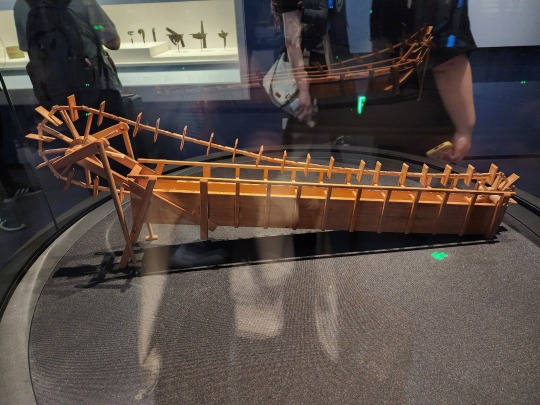
Model of a water-powered bellows/冶铁水排, Eastern Han dynasty. Just as the name implies, as flowing water pushes the water wheel around, the parts connected to the axle will pull and push on the bellows alternately, delivering more air to the furnace for the purpose of casting iron.

The Nine Chapters on the Mathematical Art/《九章算术》, Fangcheng/方程 chapter. It’s a compilation of the work of many scholars from 10 th century BC until 2 nd century AD, and while the earliest authors are unknown, it has been edited and supplemented by known scholars during Western Han dynasty (also when the final version of this book was compiled), then commented on by scholars during Three Kingdoms period (Kingdom of Wei) and Tang dynasty. The final version contains 246 example problems and solutions that focus on practical applications, for example measuring land, surveying land, construction, trading, and distributing taxes. This focus on practicality is because it has been used as a textbook to train civil servants. Note that during Han dynasty, fangcheng means the method of solving systems of linear equations; today, fangcheng simply means equation. For anyone who wants to know a little more about this book and math in ancient China, here’s an article about it. (link goes to pdf)
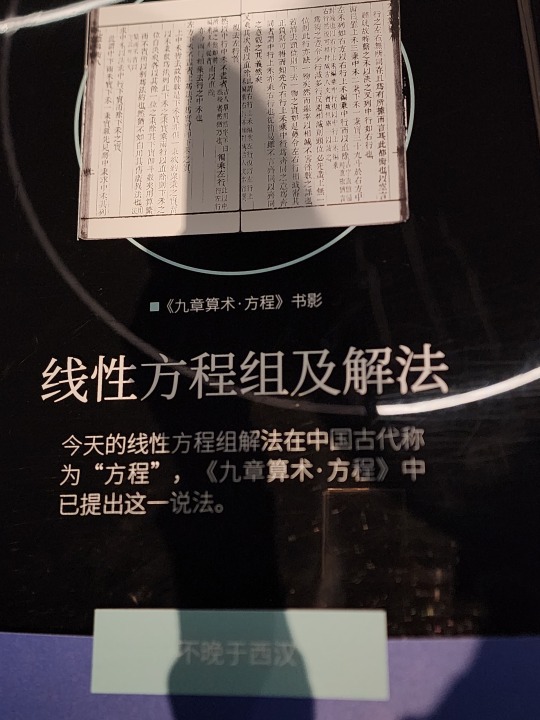
Diagram of a circle in a right triangle (called “勾股容圆” in Chinese), from the book Ceyuan Haijing/《测圆海镜》 by Yuan-era mathematician Li Ye/李冶 (his name was originally Li Zhi/李治) in 1248. Note that Pythagorean Theorem was known by the name Gougu Theorem/勾股定理 in ancient China, where gou/勾 and gu/股 mean the shorter and longer legs of the right triangle respectively, and the hypotenuse is named xian/弦 (unlike what the above linked article suggests, this naming has more to do with the ancient Chinese percussion instrument qing/磬, which is shaped similar to a right triangle). Gougu Theorem was recorded in the ancient Chinese mathematical work Zhoubi Suanjing/《周髀算经》, and the name Gougu Theorem is still used in China today.

Diagram of the proof for Gougu Theorem in Zhoubi Suanjing. The sentence on the left translates to "gou (shorter leg) squared and gu (longer leg) squared makes up xian (hypotenuse) squared", which is basically the equation a² + b² = c². Note that the character for "squared" here (mi/幂) means "power" today.

This is a diagram of Zhang Heng’s seismoscope, called houfeng didong yi/候风地动仪 (lit. “instrument that measures the winds and the movements of the earth”). It was invented during Eastern Han dynasty, but no artifact of houfeng didong yi has been discovered yet, this is presumably due to constant wars at the end of Eastern Han dynasty. All models and diagrams that exist right now are what historians and seismologists think it should look like based on descriptions from Eastern Han dynasty. This diagram is based on the most popular model by Wang Zhenduo that has an inverted column at the center, but this model has been widely criticized for its ability to actually detect earthquakes. A newer model that came out in 2005 with a swinging column pendulum in the center has shown the ability to detect earthquakes, but has yet to demonstrate ability to reliably detect the direction where the waves originate, and is also inconsistent with the descriptions recorded in ancient texts. What houfeng didong yi really looks like and how it really works remains a mystery.
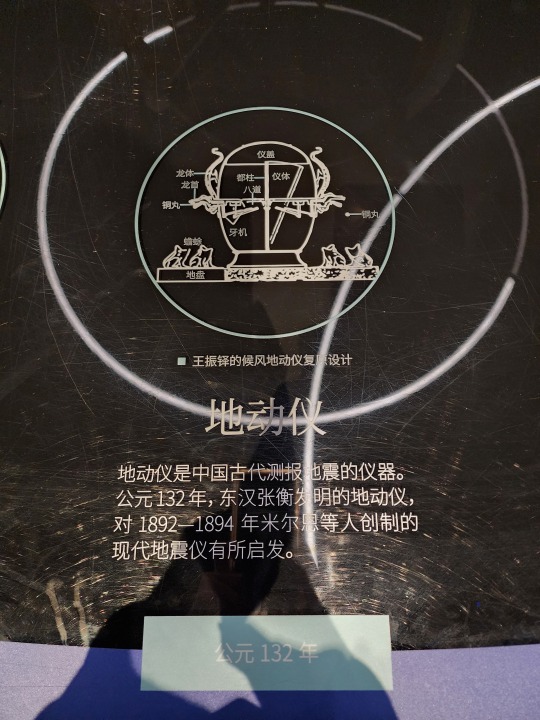
Xin dynasty bronze calipers, the earliest sliding caliper found as of now (not the earliest caliper btw). This diagram is the line drawing of the actual artifact (right).


Ancient Chinese "Jacquard" loom (called 提花机 or simply 花机 in Chinese, lit. "raise pattern machine"), which first appeared no later than 1st century BC. The illustration here is from the Ming-era (1368 - 1644) encyclopedia Tiangong Kaiwu/《天工开物》. Basically it's a giant loom operated by two people, the person below is the weaver, and the person sitting atop is the one who controls which warp threads should be lifted at what time (all already determined at the designing stage before any weaving begins), which creates patterns woven into the fabric. Here is a video that briefly shows how this type of loom works (start from around 1:00). For Hanfu lovers, this is how zhuanghua/妆花 fabric used to be woven, and how traditional silk fabrics like yunjin/云锦 continue to be woven. Because it is so labor intensive, real jacquard silk brocade woven this way are extremely expensive, so the vast majority of zhuanghua hanfu on the market are made from machine woven synthetic materials.

Chinese purple is a synthetic pigment with the chemical formula BaCuSi2O6. There's also a Chinese blue pigment. If anyone is interested in the chemistry of these two compounds, here's a paper on the topic. (link goes to pdf)

A list of common colors used in Qin and Han dynasties and the pigments involved. White pigment comes from chalk, lead compounds, and powdered sea shells; green pigment comes from malachite mineral; blue pigment usually comes from azurite mineral; black comes from pine soot and graphite; red comes from cinnabar; ochre comes from hematite; and yellow comes from realgar and orpiment minerals.

Also here are names of different colors and shades during Han dynasty. It's worth noting that qing/青 can mean green (ex: 青草, "green grass"), blue (ex: 青天, "blue sky"), any shade between green and blue, or even black (ex: 青丝, "black hair") in ancient Chinese depending on the context. Today 青 can mean green, blue, and everything in between.

Western Han-era bronze lamp shaped like a goose holding a fish in its beak. This lamp is interesting as the whole thing is hollow, so the smoke from the fire in the lamp (the fish shaped part) will go up into the neck of the goose, then go down into the body of the goose where there's water to catch the smoke, this way the smoke will not be released to the surrounding environment. There are also other lamps from around the same time designed like this, for example the famous gilt bronze lamp that's shaped like a kneeling person holding a lamp.


Part of a Qin-era (?) clay drainage pipe system:
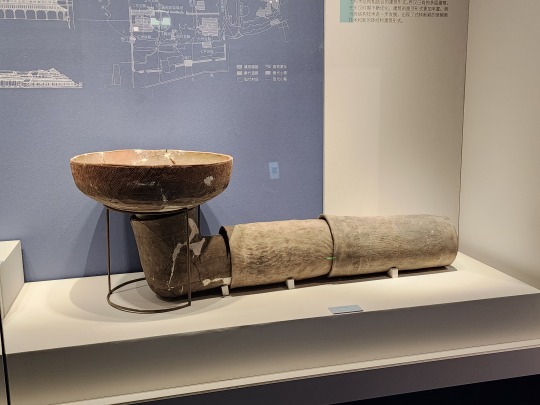
A list of canals that was dug during Warring States period, Qin dynasty, and pre-Emperor Wu of Han Han dynasty (475 - 141 BC). Their purposes vary from transportation to irrigation. The name of the first canal on the list, Hong Gou/鸿沟, has already become a word in Chinese language, a metaphor for a clear separation that cannot be crossed (ex: 不可逾越的鸿沟, meaning "a gulf that cannot be crossed").
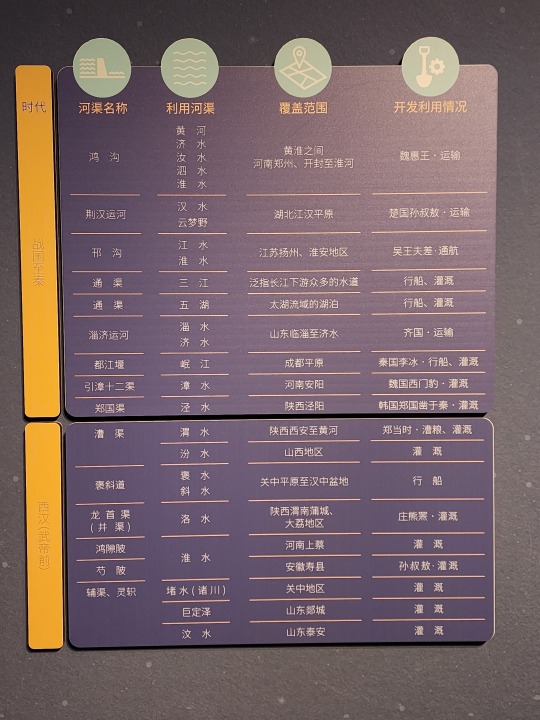
Han-era wooden boat. This boat is special in that its construction has clear inspirations from the ancient Romans, another indication of the amount of information exchange that took place along the Silk Road:

A model that shows how the Great Wall was constructed in Qin dynasty. Laborers would use bamboo to construct a scaffold (bamboo scaffolding is still used in construction today btw, though it's being gradually phased out) so people and materials (stone bricks and dirt) can get up onto the wall. Then the dirt in the middle of the wall would be compressed into rammed earth, called hangtu/夯土. A layer of stone bricks may be added to the outside of the hangtu wall to protect it from the elements. This was also the method of construction for many city walls in ancient China.

A list of the schools of thought that existed during Warring States period, their most influential figures, their scholars, and their most famous works. These include Confucianism (called Ru Jia/儒家 in Chinese; usually the suffix "家" at the end denotes a school of thought, not a religion; the suffix "教" is that one that denotes a religion), Daoism/道家, Legalism (Fa Jia/法家), Mohism/墨家, etc.

The "Five Classics" (五经) in the "Four Books and Five Classics" (四书五经) associated with the Confucian tradition, they are Shijing/《诗经》 (Classic of Poetry), Yijing/《易经》 (also known as I Ching), Shangshu/《尚书》 (Classic of History), Liji/《礼记》 (Book of Rites), and Chunqiu/《春秋》 (Spring and Autumn Annals). The "Four Books" (四书) are Daxue/《大学》 (Great Learning), Zhongyong/《中庸》 (Doctrine of the Mean), Lunyu/《论语》 (Analects), and Mengzi/《孟子》 (known as Mencius).

And finally the souvenir shop! Here's a Chinese chess (xiangqi/象棋) set where the pieces are fashioned like Western chess, in that they actually look like the things they are supposed to represent, compared to traditional Chinese chess pieces where each one is just a round wooden piece with the Chinese character for the piece on top:
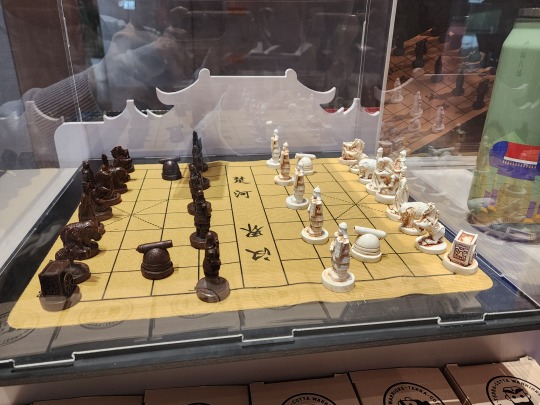
A blind box set of small figurines that are supposed to mimic Shang and Zhou era animal-shaped bronze vessels. Fun fact, in Shang dynasty people revered owls, and there was a female general named Fu Hao/妇好 who was buried with an owl-shaped bronze vessel, so that's why this set has three different owls (top left, top right, and middle). I got one of these owls (I love birds so yay!)


And that concludes the museums I visited while in Xi'an!
#2024 china#xi'an#china#shaanxi history museum qin and han dynasties branch#chinese history#chinese culture#chinese language#qin dynasty#han dynasty#warring states period#chinese philosophy#ancient technology#math history#history#culture#language
96 notes
·
View notes
Text
Concrete has allowed the housing and infrastructure booms of the last century that have lifted millions into better, safer living conditions. That task is not over, with an estimated 600–756 million dwellings needed globally to reach the UN 2030 goal of universal housing access, primarily in the global south; this is where 94 per cent of cement is now produced, making it essential to many livelihoods and economies. And, while arguably modern technologies such as scanning equipment, design tools and modelling software make it more possible to use less‑standardised materials than concrete for building at scale, there are functions for which concrete is genuinely hard to replace. Deep piling, long‑span bridges, tall buildings and complex energy infrastructures are all innovations of the concrete age. Since we cannot rely on green concrete at scale, but we also cannot get away from using concrete in some applications, a more nuanced approach must be embraced. The overall use of concrete must be dramatically reduced in favour of a more diverse palette of materials and design strategies. Countries with large existing material stocks must reuse and repair existing buildings, maximising the value of the matter that they already have. Where such places genuinely cannot make do without concrete, recycled cement technologies have a promising role to play. In countries which have a need for mass new building and infrastructure programmes, designers must work with a more varied range of materials as appropriate and affordable to the site and context. This includes bricks, formed from clays or waste material and fired with renewable energy, non‑fired bio‑based materials and stone, reimagining traditional methods of construction and introducing modern innovations that enable their use at scale. Concrete should be reserved for the infrastructure that cannot be done without – data centres to feed ChatGPT hardly count as essential concrete infrastructure.
9 October 2024
52 notes
·
View notes
Text
Shockwave x Reader
Warnings: Lack of humanity and empathy, denial of subtle emotional attachment
Basically, Shockwave has subtle feels and examines his human companion experiment. Meanwhile, human just wants to explain the FNAF lore. No actual explanations of FNAF lore aside from mentioning a name. Struggled to portray and characterize Shockwave despite him being one of my Favorite characters. I'm used to writing emotionally volatile individuals. I hope someone can enjoy this, I liked writing it.
Takes place after TFP and maybe sometime during RiD. Shockwave is living on his own in a laboratory he constructed on Earth. Might make this a series.
ao3 link
Companion? Negative. Experiment? Logical.

Shockwave considers himself to be a logical being. No- he doesn't consider himself to be logical- he is logical.
But his small organic experiment truly tests his rarely fluctuating patience.
Said organic is currently sitting on his desk, incessantly chatting and yapping, distracting him from his current experiment.
He originally procured the organic for study, curious about Earth's dominant lifeforms. The creature piqued his curiosity, so he originally refrained from dissecting it.
He's currently questioning that decision.
"So, his name was William Afton, okay?"
Shockwave continues to ignore the organic struggling to explain the story behind some Organic Youngling games. He hasn't the faintest clue why the organic is insistent on 'educating' him.
"Cease your nonsense." Shockwave interrupts the human, bluntly and unemotionally. Not angrily, of course, Shockwave is much too calm to be swayed by a human. Simply.. displeased. The human flinches and Shockwave stares curiously. His finials twitch briefly as he examines the micro-expressions on the Organic's face.
Humans are so similar to Cybertronians, yet so.. different at the same time. Perhaps it's due to humans being closely related to Unicron. He ponders whether that would make humans a cousin species to Cybertronians, or perhaps a less evolved fleshy variant.
Despite their small organic processors, they're capable of intelligence and emotional capacity. Many of his fellow Decepticons compare humans to insects, which regarding their size is an exaggeration but not entirely inaccurate.
Homo sapiens. A widespread primate species. Their method of fueling is primitive but effective enough. They digest their fuel and their body expells the waste produced afterwards.
Their designs are intricate and delicate. Shockwave is aware of his large size and thickness compared to other Cybertronians as well. If he were to angle his digit just the wrong way, his human experiment would be offline.
He barely noticed how he was caressing their small form- no, not caressing, studying. He examines them up and down, his digits lingering on their skin through their clothes.
Humans don't come with natural plating, they construct their own. Innovative. Intelligent. Humans are inherently illogical, emotionally driven, and messy. But at the same time, they're intelligent enough to create weaponry and protection and homes.
Compared to Cybertronians they're primitive, but they've existed for far less time. Shockwave ponders how humans would end up if left to their own devices. How would they evolve? How would they change?
"Shockwave?" His human speaks up.
His finials twitch, and he nods in acknowledgment.
"Can.. can I tell you more about the FNAF lore now?"
...The human may be illogical, but they are Shockwave's. He will continue to study them as they age and decompose. They are.. an interesting and prime test subject.
#TFP#Transformers: Prime#Transformers Prime#Shockwave#Tfp Shockwave#Shockwave Tfp#x reader#Shockwave x reader#Transformers x reader#tfp x reader#Passport Writes
254 notes
·
View notes
Text
The link between warfare and technological innovation has been well documented [...]. World War II was a particularly intense crucible of technological change, and the repurposing of military technologies and industries in the forging of a new post-war consumer [economy] is crucial [...]. Processes of technological bricolage turned the machines of war onto the natural world as global powers competed to cement their economic and imperial hegemony. In Great Britain’s post-war “groundnut scheme” in its East African territories (1946-51), this collision of nature, military hardware, and technical expertise was part of efforts to both produce more fats for the British diet and to demonstrate to the world (most importantly the United States) that, through a newly energized science-led developmentalism, British colonialism still had a “progressive” role to play in the postwar world.

The aim was to produce millions of tons of peanuts across Tanganyika using the latest methods of advanced scientific agriculture. The environmental conditions in the north, where the scheme was to begin, were known to be especially trying, not least the dry climate [...]. But faith in the power of mechanized agriculture was such that any natural limits were thought to be readily surmountable.
The groundnut scheme was to be, as its Director put it in an interview with the Tanganyika Standard, a “war” with nature, and an “economic Battle of Alamein” waged over some three million acres by an army of colonial technicians - many recruited from military ranks - and local laborers, for many of whom the scheme represented their first entry into the wage labor market.
But it wasn’t just the rhetoric of war that was repurposed.
Lancaster bombers were kitted out to survey and discover “new country” in East Africa for agricultural development. [...] [T]ractors and bulldozers from military surplus stores in Egypt proved unable to tackle the hard ground and tough vegetation, so the planners turned to a novel solution: repurposing surplus Sherman M4A2 tanks. The Vickers-Armstrong factory in Newcastle-Upon-Tyne set about rearranging key elements of the tanks’ construction [...]. The tractors, christened “Shervicks” for their hybrid origins, were [...] thought to be particularly suited to large-scale earth-moving and to the kind of heavy duty “bush clearing” that was required in Tanganyika.
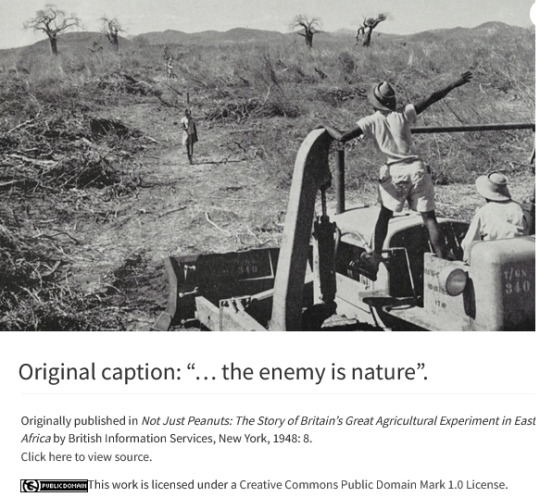
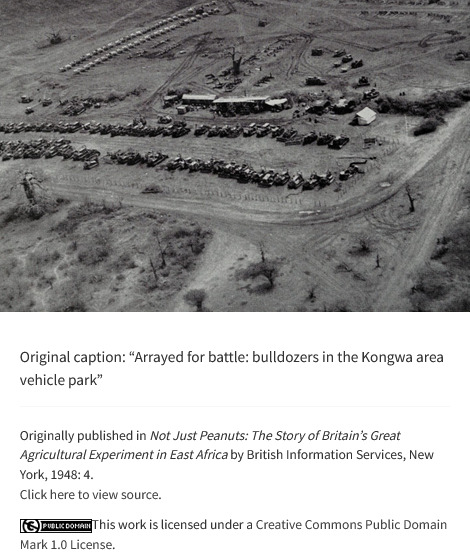
Officials sought to dismiss concerns that large-scale bush clearing would have wider environmental consequences, using the well-worn colonial trope that any observed changes in local climate or erosion patterns were due to the “primitive” agricultural practices of the locals, not to the earth-moving practices of the colonists. [...] As the plants continued to wilt in the sun, [...] [t]he stakes were high. As [J.R.] of the Colonial Development Corporation put it in a letter: “Our standing as an Imperial power in Africa is to a substantial extent bound up with the future of this scheme. To abandon it would be a humiliating blow to our prestige everywhere.” The only option left was to try and bend the weather itself to the scheme’s will, by seeding the clouds for rain. [...] “Balloon bombs” (photographic film canisters tethered to weather balloons) and a repurposed Royal Navy flare gun were used to target individual clouds [...]. The scheme itself has survived as a cautionary tale of governmental hubris, but it is instructive too as a case study of how technologies of war have been turned against other foes.
---
All text above by: Martin Mahony. “The Enemy is Nature: Military Machines and Technological Bricolage in Britain’s ‘Great Agricultural Experiment.’“ Environment and Society Portal, Arcadia (Spring 2021), no. 11. Rachel Carson Center for Environment and Society. doi:10.5282/rcc/9191. [Bold emphasis and some paragraph breaks/contractions added by me. Images and their captions are shown unaltered as they originally appear in Mahony's article. Public Domain Mark 1.0 License for images: creativecommons dot org/publicdomain/mark/1.0/]
196 notes
·
View notes
Text




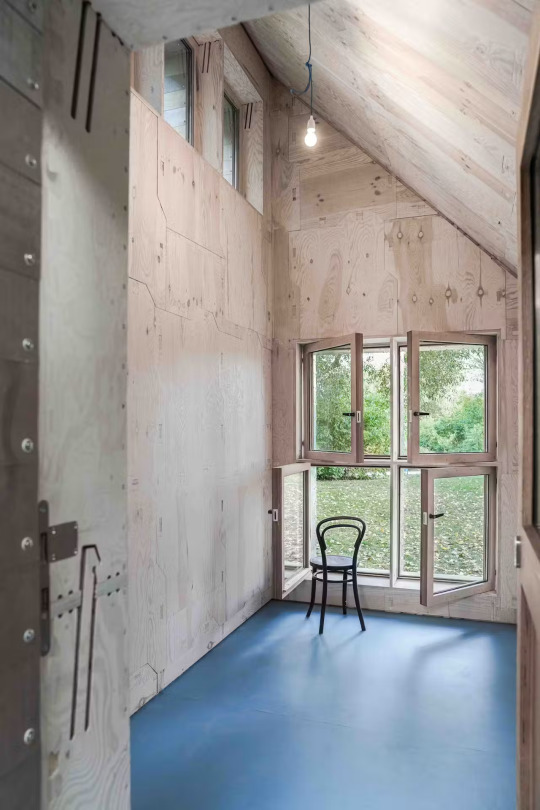


Digital House, Wismar, Germany,
the “Digital House” is a prototypical building entirely digitally designed, fabricated, and assembled without the need for tools. Julian Krüger (Munich University of Applied Sciences) and Benjamin Kemper (Wismar University of Applied Sciences) developed a sustainable, cost-effective building system based on innovative plug-in construction methods.
In a grove not far from the Faculty of Architecture and Design at Wismar University, a small house with a shiny, silvery facade and a steep, west-facing mono-pitch roof stands 6.5 m high on a footprint of 3.3 × 4.9 m. Light enters the spacious interior through a continuous window ribbon and four large windows cutting through the facade made from recycled aluminum sheets.
The house features an inventive wood construction system CNC-milled from 24mm plywood, allowing two people to assemble it quickly without any tools or hardware, such as screws or nails. This flexible system, which allows for disassembly and reuse, strengthens the project's approach to sustainability.
The wooden structure is clad with plywood panels inside and a vapor-permeable wood fibreboard on the outside and insulated with eco-friendly wood fiber.
The "Digital House" rests on six ground screws, enabling quick and traceless disassembly and eliminating the need for concrete or groundwork.
Julian Krüger + Benjamin Kemper
#art#design#architecture#minimal#nature#interior design#retreat#cabin#digital#digital architecture#prototype#sustainability#sustainable architecture#recycling
192 notes
·
View notes
Text

Multi-dwelling buildings on Kiseleff Boulevard Bucharest, Romania Built in 1956-1959. Architects: T. Niga, L. Garcia, I. Serban © B.A.C.U / Photo by Dumitru RUSU . . An extremely interesting ensemble for the innovative constructive methods, the group of buildings is generously set back from the street front, surrounded by gardens and unusually decorated for that late Stalinist period. The buildings were designed to accommodate diplomats and state officials, having a much higher standard than the usual range. In the 1956-59 stage, it comprised three 3-storey slab-shaped buildings and a club (today in private property). Arranged in a free line, generously distanced, the buildings are still lining the Kiseleff boulevard, discreetly hidden by vegetation. They have completely glazed entrances marked by staircases allowing easy access to the two apartments on each floor, where the descendants of socialist public servants go on with their modest lives. source and location: http://romd.socialistmodernism.com/index.php/2018/11/01/unitati-cu-mai-multe-locuinte/?fbclid=IwAR3Q9CtZqU9g_qS6JnA8W_cSawWJcdrLpzPvZNnDi1DkYP71OJQuVPYhOkc
79 notes
·
View notes
Note
Hi! I love your metas and I had a question if you don't mind. I love Barcus but I'm a bit confused by the Ironhand gnomes and why they were so mad at the Gondians? Did I maybe miss something?
Omg, I'm so glad someone asked me this! Thank you, anon. I broached this exact subject with my friend a few days ago, and I'd already considered writing a post about it, so this was the kick I needed! Barcus is hands down my favourite NPC (perhaps of all time) and the gnome plight is easily my favourite side quest in the entire game, so I'm excited to share what I've learned!
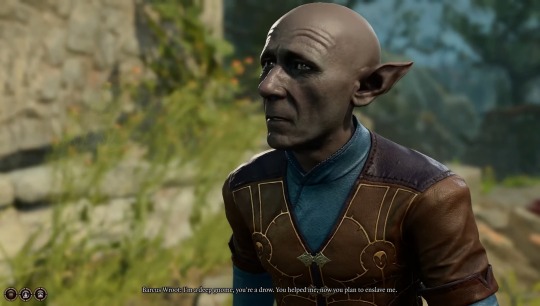
To preface, I'd like to mention that most gnomes, according to D&D lore, live in clans and keep to themselves. This is especially true for deep gnomes, as the Underdark is an exceedingly dangerous homeland. Their people are often enslaved by drow or duergar, or eaten by other nefarious creatures that lurk in the shadows. As such, they have become a profoundly somber and cynical race, relying only on each other for survival. They're also extremely wary of strangers, as Barcus perfectly demonstrates when we first meet him.
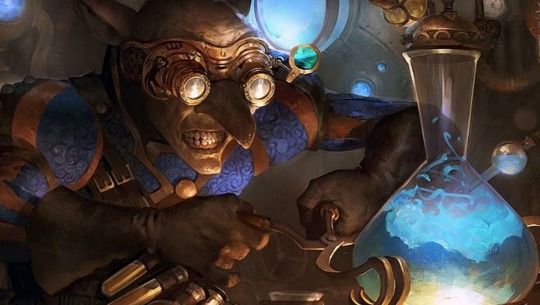
Now, a history lesson. The Ironhand Gnomes, who at some point left the Underdark, worked in Baldur's Gate for generations, providing the city with the best mechanomagical inventions the populace had ever seen. Though they still kept to themselves and worked in isolation, they were well respected by the citizens, and flourished enough to inspire other gnomes to seek a new life in the city as well. This may not have been their goal, but whether they meant to or not, they brought gnomish innovation to the forefront of one of the most multicultural cities in all of Faerûn.
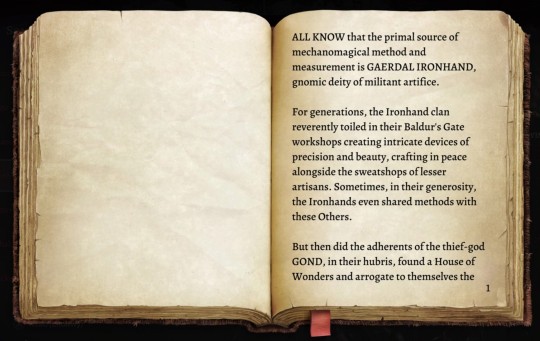
More importantly, the Ironhand Gnomes worshipped a lesser deity called Gaerdal Ironhand, who Wulbren's ancestor, Wolverforce Bongle, allegedly conversed with. Massive however, in all of my research, I haven't been able to find any evidence that he was truly capable of such a feat, nor is he ever referred to as a "Chosen" by either himself or anyone from his clan. Therefore, it's possible this is nothing more than an unsubstantiated claim made by zealots. A book called Ironhand Gnomes: Our Grievances can be found in the gnome hideout in Act 3, verifying some of this information, but it's glaringly biased against the Gondians, with radically religious and violent undertones.
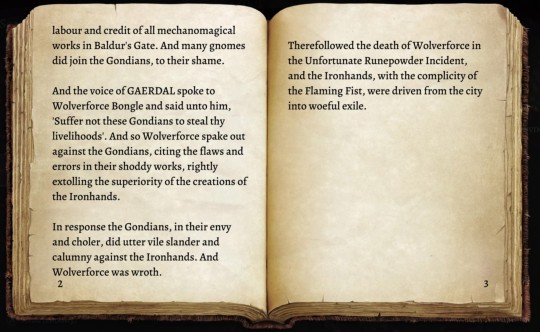
But where did this hatred come from? Well, according to the book, the Ironhand Gnomes shared some of their expertise with other clans, and some of those clans took what they learned and opened their own workshops. The Gondians, who worship Gond, did particularly well, constructing their own factories and becoming quick competition. They even built a Gondian Church in the city, and attributed their success to Gond; god of craft, smithing, and inventiveness. For whatever reason, the Ironhands didn't appreciate this and accused the Gondians of stealing their methods and designs, as well as pointing out flaws in their "shoddy" craftsmanship.
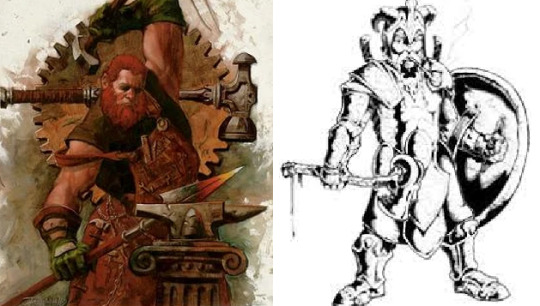
However, Gondian work was relatively flawless, as well as artifice-based, meaning it relied on science and raw materials. The Ironhands specialised in mechanomagical inventions, meaning they imbued their engines with arcane influence. This put the Gondians and Ironhands at odds with each other, as Gond espoused artifice supremacy, whereas Gaerdal Ironhand, according to Wolverforce, accused Gond of being a thief. So yes, we've reached the crux of the issue—religious turmoil. Both gods, I should mention, are good-aligned and easily misinterpreted, so of course that adds another layer of complications.
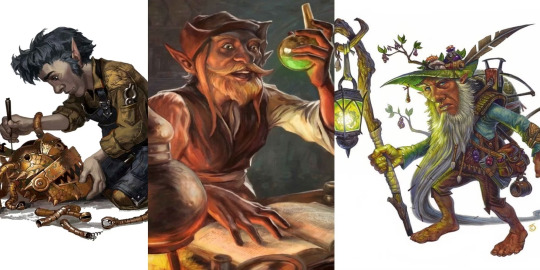
In response to the Ironhand's accusations, the Gondians started slandering the Ironhand clan, losing them favour in the city. In other words, the feud quite literally became a he said/she said situation, with both clans acting like petty children. Whether or not the Ironhand Gnomes taught the Gondians a few tricks, they weren't owed credit for their inventions. That would be like my friend showing me how to use Adobe Animate, then demanding credit for all of my artwork thereafter ... and all while criticising it. And the Gondians, though attempting to protect their reputation, had no right to spread lies about the Ironhand clan, not all of whom participated in the drama. They could've let their work speak for itself.

But this war of finger-pointing dragged on, with both sides losing and gaining support from confused Baldurians. Eventually, the Ironhands became desperate to get the upperhand, rousing Wolverforce to experiment with the thought-to-be mythical runepowder. This led to what became known as the "Unfortunate Runepowder Incident", wherein the overweening Wolverforce caused a massive explosion, killing himself and countless others in the blast. Wulbren blames this tragedy on the Gondians alone, and many Ironhands seem to feel it was the root of their exile, but there's more to it.

In reality, the Ironhand Gnomes were banished from Baldur's Gate because they aligned themselves with Sarevok Anchev, the Bhaalspawn who tried to destroy the city in the first game. For some reason, Wulbren completely glosses over this detail, likely because he can't bring himself to admit the Ironhands are responsible for their own downfall. In fact, he brushes it off, as if it's some insignificant happenstance that deserves forgiveness without merit. After all, it happened over a century ago. Then, in Act 3, he says a painfully backwards line about how he thinks the Gondians would've joined Sarevok, if given the chance. But they did have a chance, and they didn't join him. The Ironhands did. As far as I'm concerned, this highlights Wulbren's extensive denial.
Which brings me around to Barcus and why he's such an endearing character. He doesn't care about ancient feuds or gnome supremacy. He made a name for himself, despite his clan's reputation. The Gondians never saw him as an enemy, and he in turn saw the value in their work. He prefers diplomacy and open dialogue, and he abhors violence to the highest degree. With a little hard work, he proved that the Ironhand Gnomes could've redeemed themselves without resorting to such extreme and radical measures; which is why I will always argue for him to take leadership. He's the best. He's everything. He is the shining future of unity and creation.
#bg3#baldur's gate 3#barcus wroot#bg3 barcus#barcus my beloved#wulbren bongle#bg3 wulbren#ironhand gnomes#gondians#dnd#d&d#dungeons and dragons#gnome post
70 notes
·
View notes
Text
Here are seven ways to make programming more engaging for beginners.
Introduction
For newcomers, programming might be frightening. For many, the new material's syntax, logic, and sheer amount might be depressing. Nonetheless, programming doesn't have to be very difficult or tiresome. Programming can be made more engaging and fulfilling by incorporating innovative, enjoyable, and useful methods. This article will examine seven methods for improving novice programmers' engagement, which will make learning programming easier and more pleasurable.
1. Start With Visual Programming Tools
Start with visual programming tools like Scratch, Blockly, or Tynker before writing complex code. Using these platforms, novices can drag and drop code blocks to construct simple programs, games, and animations. Visual tools make learning more interactive and enjoyable by breaking down complicated programming concepts and provide instantaneous visual feedback.
Benefits:
Improves understanding of programming fundamentals.
Allows newcomers to see the effects of their efforts immediately.
Encourages creativity through cartoons and games.
2. Focus On Interactive Learning Platforms
Students can write code directly in their browsers and see the results in real time with interactive classes offered by platforms like Codecademy, Khan Academy, and freeCodeCamp. These platforms often provide assistance or instant feedback and break down programming into manageable tasks. Interactive learning helps users solve difficulties and keeps the learning process moving forward while lowering irritation.
Benefits:
Immediate feedback allows for easy error correction.
Lessons are organised into convenient parts.
Gamified learning systems can help to sustain engagement.
3. Work On Real-Life Projects Early
Learning programming through real-world applications increases its relevance and fun factor. Novices can concentrate on projects that pique their interest, such creating a simple app, automating a tedious task, or creating a personal website. Students get a feeling of purpose from real-world projects, which piques their interest in coding and makes them more enthusiastic about it.
Benefits:
Improves understanding of theoretical concepts.
Increases confidence as students create actual things.
Offers a clear purpose and a sense of accomplishment.
4. Learn Through Games
Learning programming can be facilitated by creating or playing games. Some examples of platforms and games designed specifically for teaching programming are CodeCombat, Robocode, and CheckiO. Through the resolution of code puzzles, students advance in these games that transform coding assignments into adventures.
Benefits:
Creates a fun and competitive learning atmosphere.
Encourages critical thinking and problem-solving skills.
Engages students who may find standard lessons unappealing.
5. Incorporate Pair Programming
When two programmers work together on a single task, it's called pair programming. Real-time code reviews are performed by one person after it has been written. Through discussion and shared knowledge, this collaborative learning approach helps students acquire problem-solving methods while also making programming more socially engaging.
Benefits:
Promotes teamwork and communication skills.
Provides fast feedback and reduces errors.
Helps to overcome learning plateaus through shared expertise.
6. Celebrate Small Wins
Programming can occasionally seem like a laborious process with little payoff, especially when faced with challenging problems. It's crucial to acknowledge small accomplishments in order to stay motivated. Acknowledging successes, no matter how small, can give much-needed morale support.
Benefits:
Encourages an optimistic approach to learning.
Recognising progress helps to boost confidence.
Reinforces a growth mentality, increasing learners’ resilience.
7. Join Coding Communities
Learning to program could be more enjoyable if you're a part of a helpful group. Newcomers can participate in local coding meetings and online forums like Stack Overflow and GitHub. These websites offer opportunities for collaboration, mentoring, and inspiration from people who share similar interests.
Benefits:
Access to a plethora of common knowledge.
Promotes collaboration on open-source initiatives.
Creates a network of mentors and peers to share experiences and insights.
Conclusion
By using these suggestions, learning to program doesn't have to be a daunting task; instead, it can be interesting and fun. In order to keep beginners interested in programming and inspired, we at the School of Coding & AI employ a variety of strategies, including interactive tools, real-world projects, and community involvement.
#coding#programming#branding#marketing#python#commercial#graphic design#student life#study motivation
26 notes
·
View notes
Text
3D Printing in Architecture

3D printing, once a novelty in the tech world, has now firmly established itself as a game-changer in various industries, including architecture. The ability to create intricate models, prototypes, and even full-scale structures has opened up new possibilities for architects, engineers, and builders. In this blog post, we'll explore how 3D printing is revolutionizing architecture, from design concepts to construction practices.
Design Innovation
One of the most significant impacts of 3D printing in architecture is the freedom it provides in design. Traditional methods often limit architects to certain shapes and structures due to material and construction constraints. However, with 3D printing, these limitations are lifted. Architects can now experiment with complex geometries and organic forms that were previously impossible or too costly to achieve. This has led to a surge in innovative designs, pushing the boundaries of what architecture can be.
Prototyping and Modeling
Before the advent of 3D printing, creating detailed architectural models was a time-consuming and expensive process. With 3D printing, architects can quickly produce accurate scale models of their designs, allowing for better visualization and refinement. This rapid prototyping capability enables architects to identify potential issues early in the design process, saving time and resources in the long run. Additionally, clients can better understand the architect's vision through tangible models, leading to more effective communication and collaboration.
Sustainability and Efficiency
3D printing also offers significant benefits in terms of sustainability and construction efficiency. Traditional construction methods often generate a considerable amount of waste due to material overuse and mistakes. In contrast, 3D printing uses only the necessary amount of material, significantly reducing waste. Additionally, many 3D printing materials can be recycled or are made from sustainable resources, making this technology more environmentally friendly.
Moreover, 3D printing can streamline the construction process. Structures can be printed on-site, reducing the need for transportation and minimizing the carbon footprint associated with moving materials and equipment. This method also allows for faster construction times, which is particularly beneficial for large-scale projects or emergency housing needs.
Cost-Effective Construction
The cost of building with traditional methods can be prohibitive, especially for complex or custom designs. 3D printing offers a more cost-effective alternative by reducing labor costs and material waste. The precision of 3D printing ensures that only the exact amount of material needed is used, which not only lowers costs but also increases the structural integrity of the building. For developing countries or regions with limited resources, 3D printing presents a viable solution for affordable housing and infrastructure.
Challenges and Future Prospects
While 3D printing in architecture holds great promise, it is not without challenges. The technology is still relatively new, and large-scale 3D printing for buildings requires further development. Issues such as material limitations, regulatory hurdles, and the need for skilled operators must be addressed. However, ongoing research and innovation in the field are likely to overcome these challenges in the coming years.
#architectdesign#design#interior design#home interior#interiordoor#interior decorating#architecture#interiorstyling#interiors#home#3D#3d printing
32 notes
·
View notes
Text

Liquid metal microdroplets enable soft, flexible electric connections across and through circuit layers
If a phone or other electronic device were made of soft materials, how would that change its use? Would it be more durable? If hospital health monitoring equipment were made of less rigid components, would it make it easier for patients to wear? While electronics of that type may still be far in the future, Virginia Tech researchers have developed an innovative method for constructing the soft electronic components that make them up. The focus of a project by the team of Michael Bartlett, principal investigator and associate professor in the Department of Mechanical Engineering, is on the circuits that manage all the electronic connections inside. Published inNature Electronics, this novel technique uses liquid metal microdroplets to create a stair-like structure that forms small conductive passages called vias. These vias create electric connections through and across circuit layers without needing drilled holes in hardware, as previous techniques have.
Read more.
#Materials Science#Science#Liquid metals#Fluid dynamics#Electronics#Circuits#Virginia Tech#Soft materials
17 notes
·
View notes